

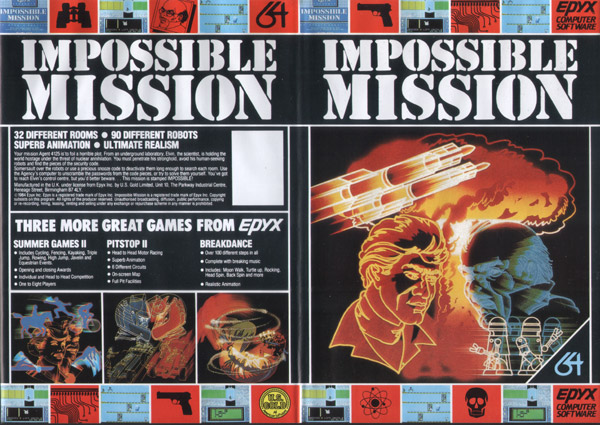 |
| Dennis Caswell's most famous creation (UK disk artwork) |
Dennis Caswell is a legend. No question about it. But for all the plaudits, accolades and recognition he may have gotten for his seminal work, there is a lot more to the man than just Impossible Mission. Earlier work at Starpath and later work for other companies are all present and correct on his CV. Nowadays though he has little to do with the gaming world, though he still retains a strong connection with computing. I caught up with him to ask a few questions...
First of all, a bit about yourself such as location, age (if it's not impolite!), job etc... up to you how much you want to divulge!
Here's a brief curriculum vitae. I received a bachelor's degree in computer science from the University of California at Berkeley in 1979 and a Master's degree (also in computer science) from the University of California at Los Angeles in 1981. When I left UCLA, having no idea what sort of job I wanted, a former roommate informed me that his brother, who had been working for Atari, was starting up his own game company. This company eventually became Starpath. I was hired straight out of school because I had my own Apple II computer, which meant they didnıt need to buy me one, and because I could reach the top of the fourth building in Crazy Climber. When the Atari 2600 market crashed and Starpath foundered, the company was acquired by Epyx, and I went along for the ride. I eventually fell out with management (I did that easily in those days) and resigned. During my gaming years, I found my way to The Learning Company, Activision, back to Epyx again (under new management, thankfully), Sega of America, and 3DO, before leaving the game business altogether, having nearly exhausted the available supply of employers. I now live outside Seattle, Washington with my wife and two daughters and am employed as a software engineer in the aviation industry.
What was your first exposure to computers?
My first experience with programming came when I was in junior high school. Computer programming was an extracurricular activity in those days. You had to go to a location that would let you use their mainframe and learn how to use a keypunch. I learned a little bit of Fortran, but I didn't touch a computer again until I was in college, when I learned Fortran for real. Multi-user time-sharing systems (let alone personal computers) were still in the future, so I was still entering programs on punch cards.
Can you remember what mainframe computer you used at school to learn programming on? And what was Fortran like as a language to learn? I learnt it myself whilst at university (the Fortran 85 flavour) as I did an engineering degree!
My first serious exposure to programming was in 1975 at UC Berkeley, during my first college-level programming course. We wrote our programs in Fortran IV and ran them on Berkeleyıs Control Data 6400, which in those days was quite a powerful machine. The hardest thing about Fortran was trying to manipulate text and format the output of your programs using the infernal FORMAT statement. This was only made worse by the fact that the CDC 6400 used a sixty-bit word and packed ten characters of text into each word, six bits to a character. The process of isolating and manipulating individual characters, while really just a simple matter of shifting and masking, seemed hopelessly arcane to me at the time.
How did you decide that you wanted to do programming for a living?
I chose programming because I found it easy and amusing, and because I had received assurances that one could make a living at it. I'm also rather maladjusted socially and often prefer the society of machines to that of people.
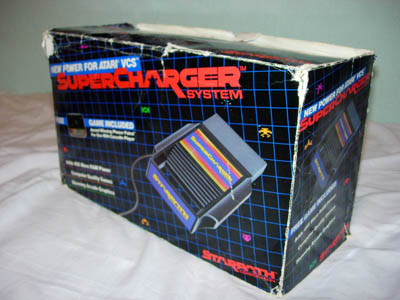 |
| The Starpath Supercharger, PAL edition |
How did you end up joining the Starpath/Arcadia company? Did you join whilst they were still called Arcadia, or after they renamed themselves Starpath?
I did join Starpath relatively early, though there were three other programmers there before me; those being Steve (Communist Mutants from Space) Landrum, Scott (Fireball) Nelson, and Steve (Suicide Mission) Hales. When I joined, the company wasn't even called Arcadia yet. It was called Acorn, which turned out to be taken, so we had to change it [Note: Acorn were a computer company in the UK who made the Electron and then the BBC Micro, most famous for being the launch platform of the game "Elite"]. Iım not sure why the name Arcadia was abandoned, but I have to presume that it was also found to be unavailable. The transition to Starpath was not entirely smooth, and the officers of the company went through several other names along the way. For a few days, we were Dimension 4, and for a brief but horrible moment, it appeared that our name would be changed to Rampro, owing to the RAM in the Supercharger cartridge. Fortunately for all concerned, it proved possible to convince our management that this name was misleading, in that we did not, in fact, sell prophylactics.
It's not strictly true that Phaser Patrol was the first game released for the Supercharger, in spite of the numeral one on the box. It was released simultaneously with the other three games Iıve mentioned, all three of which were already in development by the time I was hired. This meant that I had the advantage of the experience that had already been gained by Steve, Scott and Steve, who were the ones who did the really hard work of reverse-engineering the 2600.
The Starpath Supercharger was a device that plugged into the Atari 2600 and gave the machine more memory and the ability to load games from tape (for those who don't know what it is). Did you work on any games that didn't use the device? How did programming to run games with the device work: did they start out as standard 2600 programs and then added to, or was the device considered from the off? How was programming for the 2600 and the Supercharger done at Arcadia/Starpath?
The three Supercharger games I wrote for Starpath were my only games for the 2600. Starpath was founded by Craig Nelson and Bob Brown (two former Atari employees) with the express purpose of freeing the 2600 from one of its most confining limitations: the system contained only 128 bytes of RAM. Craig was intimately familiar with the burden this limitation imposed, having written the 2600 Backgammon cartridge while at Atari. Craig also designed the Supercharger, being an electrical engineer by training, and all of the Starpath games were designed expressly for the Supercharger in the hope of showing off its advantages. By the way, Craig is also the aforementioned brother-of-a-former-roommate.
An important advantage of the Supercharger was that the games resided in RAM rather than in ROM. In order to understand why this is so valuable, you must first understand that the 2600 did not incorporate a graphics processor of any kind. The CPU had to double as the graphics processor, and it spent most of its time furiously stuffing bits into the various shift registers that fed the video hardware. I donıt want to turn this into a seminar, but storing the code in RAM made it possible to optimize the all-important screen display code to a degree that otherwise wouldnıt have been possible. This, in turn, made it possible to render more complex displays.
All of the Supercharger games were written on Apple II computers. We tested them by either downloading them directly into the Supercharger (another advantage of the device) or by using a piece of rather crude (but still useful) debugging hardware that Craig and Bob had managed to acquire before my arrival.
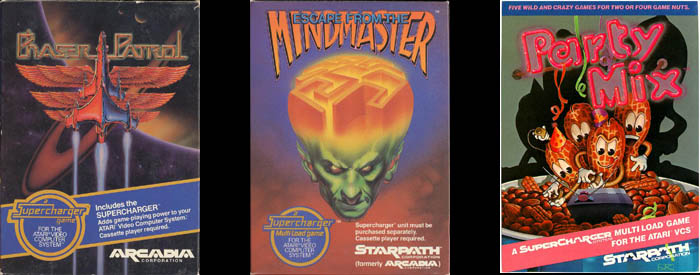 |
| The three games that Dennis Caswell worked on whilst at Starpath |
How much of Star Raiders or StarMaster (by Activision) had you played, as Phaser Patrol is very similar to them? Any stories to tell about your first commercial game?
I had never played StarMaster or Star Raiders when I was hired to work at Starpath, but Craig was a seasoned Star Commander and taught me to play Star Raiders, to which I soon became addicted. The idea of doing a game, shall we say, in the same genre as Star Raiders was not my own, but I was more than willing to tackle the project.


Escape from the MindMaster is an incredible programming feat for the 2600. Where did you get the idea for it from? How did you manage to achieve the first-person maze effect?
I donıt quite recall where the specific idea came from, but I do recall being motivated by a desire to create a fun game that had no shooting in it.
The 2600 had essentially three kinds of graphic objects: the playfield, the players, and the missiles and ball. The playfield allowed the display of more or less arbitrary graphics at extremely low resolution and was used for things like the bricks in Breakout or the walls in Combat. The players were small, 8-bit-wide objects that could be positioned anywhere on the screen. Think of the tanks in Combat. The missiles and ball were only one bit wide and were used for things like the projectiles in Combat or the ball in Breakout.
In Mindmaster, the playfield was used for the walls of the maze, with a couple of the other objects (I forget which ones) overlayed along the tops of the walls to smooth their edges, which otherwise would have been extremely blocky. One of the players was used for both the alien and the sliding panels (you'll notice they never appear together). The benefit of the first-person format is that I didnıt need to use up a graphic object to display the human player.
Unfortunately, there wasn't enough computing horsepower available to rerender the entire display in a single video frame, so I rendered half on one frame and half on the next, which is why the display breaks up a bit when you run down the halls.
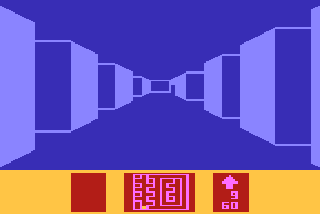
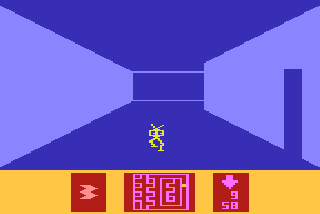
What do you know about Labyrinth, as it appears to be a somewhat earlier version of MindMaster? Was it a beta game that had some ideas and the title changed, or did you, for example, take over the project someway through?
I donıt know how Labyrinth got into circulation, and Iıve never actually seen it run, but I believe it to be simply an early proof-of-concept version of Mindmaster.
Party Mix is quite an unusual game. Who came up with the idea for a multiplayer party title? How close to the end of Starpath was that released?
It was common in those days for critics to argue that playing video games was inherently antisocial. Party Mix was an attempt on my part to prove that playing a video game could be a social activity. Dan Bunten succeeded where I failed when he created MULE, which is one of my all-time favorites. Party Mix was indeed the last Starpath title to be released with full packaging and retail distribution.
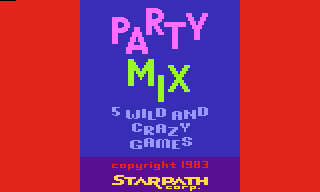
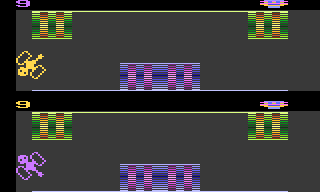
Did you do any work on the two mail-away titles, Sword of Saros and Survival Island?
None whatever. Sword of Saros was done by Steve Landrum, and Survival Island was done by Steve Mudry.
How did Epyx come about to take over the company and merge it into the main body? Was the company in financial problems leading to the takeover? Who beside yourself made the transition to Epyx?
I think I've already described the circumstances that let to the acquisition of Starpath by Epyx. The cartridge business had crashed, and Starpath was in desperate need of a buyer. All of the Starpath technical personnel went to Epyx, though some stayed longer than others. Of the original Starpath programmers, Steve Landrum went on to work on Summer Games, Pitstop II and many others, and Scott Nelson created the FastLoad cartridge, which while not a game, made Epyx a ton of money. Steve Hales left Starpath while it was still Arcadia to write games for the Atari 800.
Sweat: Decathlon was a work-in-progress for the Supercharger at the time, and many of the ideas (and code) were used to create Summer Games. Did you have any part in this at all?
No. Sweat started out as Scott Nelsonıs project and was still at a fairly early stage when Epyx acquired Starpath. It was inspired, I believe, by Microsoft Decathlon, which was quite popular at Starpath. I donıt recall any of the details surrounding the metamorphosis of Sweat into Summer Games.
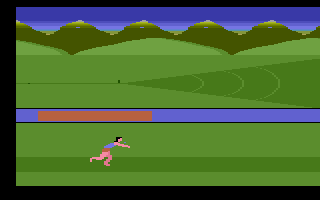
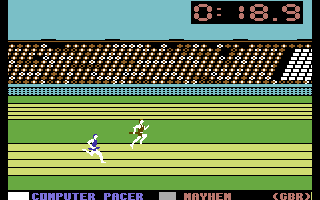
Where did the idea for Impossible Mission come from?
I got the idea for the game from watching the movie War Games, though it may not seem that they're very closely related. Somehow, the HAL-like computer in War Games led to the idea of a platform game in which the player was required to infiltrate a computer-controlled complex.
If WAR Games inspired Impossible Mission, then what was the reason for taking the name from the 60s TV show? Similar theme running along? Was the game ever considered to be called Mission Impossible and changed for the obvious legal reasons?
You've pretty much got it right. Iıve never been very good at naming things. During most of its development, I don't recall that Impossible Mission had a title. Eventually, it became time to prepare to market the thing, so we had to start calling it something. Somebody noticed the similarity to the TV show and suggested that Mission: Impossible would be appropriate but, of course, we couldnıt actually use that, so we cheated and gave it a title that was legal while still creating the desired association. A bit embarrassing, I suppose, but most people seem to have forgiven us.
Tell us some information we may not know about Impossible Mission.
Apart from what was provided by Electronic Speech Systems, the game was conceived, designed, and executed entirely by me. I had no artist or sound guy or whatever. That's why there's no credits screen. The title screen says all there is to say. There were no graphics or sound design tools, either. The graphics, for example, were drawn on graph paper and converted into hex strings that were hand-typed into the code.
As I recall, the game took about ten months to complete, though other people remember it taking less time than that. It was definitely not designed in detail before I started to code. The first thing I came up with was the animation of the running man, and part of what sold the game to the Epyx brass was the idea that the main character would be larger, more realistic, and with more elaborate animation than was typically seen in platform games at that time. After that, I more or less made it up as I went along. I think I was in my late twenties when I wrote it.
Impossible Mission was 100% assembly language (so was Battle Bugs, by the way). I don't remember all the details of how the sprites were allocated (I think the running man used three), but I do remember that where there were multiple robots that used the electrical discharge weapon, there was only one sprite for the zap, and that sprite was shared among all the robots. That is to say, it would be displayed next to one robot on one frame, the next robot on the next frame and so on. That meant that it flashed, of course, but that seemed appropriate, or at least plausible. The game also employed a split screen, which, as I recall, meant that each half of the screen could have its own set of sprites. I think there was also a sprite on the roof of the elevator. Since that sprite never overlaps vertically with the running man, one sprite could be used for both without a conflict. Apart from that, I don't remember any special shenanigans having to do with sprite limitations.
A bigger problem was getting the whole game to fit into the available memory. The running man has lots of frames of animation, and he has to run in both directions. I ended up just storing the frames for running (and flipping) in one direction and letting the game flip them back and forth as needed. The game probably spends more time doing that than anything else.
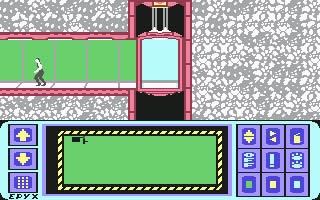
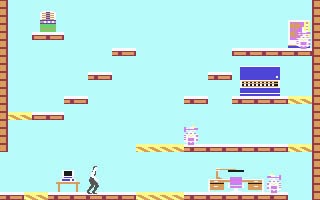
One debate that has been had is when was the game actually released. You said that it took roughly 10 months to program, which leads to think it did come out in 1984, even though all the packaging for the game says 1983.
I'm afraid I can't be of much help there. It's possible that the game was released in 1983 in the US and in 1984 in the UK, but Iım just guessing. The ten-month figure is not something I can document, nor can I tell you exactly when the first of those ten months occurred. I do know that I started working on the running man before the merger with Epyx had been finalized. I distinctly remember my elation at trading in my 2600 for a Commodore 64. When I was given permission to start a C64 project, I unplugged my 2600 and threw it out of my office and into the hall.
Are then you entirely responsible for the running man sprite who was then later used in Summer Games and further on? I have actually looked at the code and only spotted one set of animation frames for the man. Your detail about flipping him on the fly is quite clever. Was that a cycle intensive process or quite easy to do in the end?
I did create the running man myself, but I had no involvement with Summer Games, so I canıt tell you how closely related the Summer Games running man is to mine. Since mine was done first, I dare say that it had some influence, but, to the best of my recollection, I had no involvement in its incorporation (if thatıs the right word) into Summer Games.
Reversing the running manıs sprites did take a great deal of the processor's time. Fortunately, Impossible Mission was not otherwise computationally intensive, so there was enough time to spare.
The speech was an impressive and, at the time, incredible addition to the game. Tell us some information about how it came to be added.
The speech in the game was real, digitized speech. The performances were provided by Electronic Speech Systems, who also provided the software for reproducing the speech on the Commodore 64. I told them what I wanted the game to say, and when they asked me what kind of voice I had in mind, I said I was imagining a fiftyish English guy, like a James Bond villain. I was told that they happened to have such a person on their staff, so, instead of hiring an actor, they let him take a whack at it, and I thought he was just fine. I never met the guy who provided the voice, but, to my knowledge, the recordings were not altered or processed, apart from being digitized. It is certainly possible, though, that Electronic Speech Systems could have tweaked them without my knowledge. There are no other digitized sounds in the game.
I've always been under the impression the speech was added because there was enough room left to fit it in. Is this not the case then? Was the speech considered for inclusion from the start?
As I recall, the digitized speech was not planned from the start; we grafted it on later because it was relatively easy to do.
The Ghostbusters game by David Crane, which came out in early 1984, also had speech within it by ESS. Did Impossible Mission come out before it? Did you hear the speech in Ghostbusters at all and compare the games?
I barely recall the Ghostbusters game, and I think Iıve only ever seen the PC version. I can't tell you which game was first.
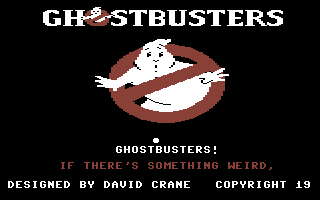
Are you aware of the sprite bug in Impossible Mission from playing the American version in Europe? For those in the dark, if a robot facing left fires on the leftmost side of the screen, the agent gets fried no matter where he is in the room. No doubt it resulted from some of the differences in the VIC chips relating to how you made the laser animation work.
Thatıs a new one on me. I'm afraid I canıt help you there either.
Who came up with the nine letter passwords in the game (what you get from fitting the puzzle pieces together)?
That would have been me. I probably just used the first eight nine-letter words I thought of. Recently I have found a source listing of Impossible Mission tucked away in a drawer, and I looked them up. Here they are: swordfish, asparagus, artichoke, crocodile, alligator, albatross, butterfly, and cormorant.
And speaking of the puzzle pieces, genius concept. Did the idea come from your earlier days using punch cards? What is sad is that the idea to my knowledge has not been used since. Did you ever get any feedback saying that people found that part of the game too hard?
You're very kind, but it's really just a jigsaw puzzle. It does seem likely that I made the puzzle pieces resemble punch cards for sentimental reasons. I haven't heard specific feedback about the puzzle pieces, but I have observed first-hand that the mental skills required to assemble the puzzles (you have to be able to reflect and superimpose images in your head) seem entirely distinct from those required to defeat the robots and the Rover ball. People who can handle the joystick twitching fairly easily have been known to struggle with the puzzle pieces.
Why furniture to have to search? The idea in itself is quite unusual. That and having Elvin as being absent-minded despite being a genius. The attention to detail is terrific, that you even got us searching toilet paper!
I imagined the underground complex as being not only Elvin's workplace, but also his residence, so the standard residential accoutrements seemed appropriate. If there sometimes seems to be an implausible profusion of bathrooms, bookcases, or what-have-you, weıll just have to chalk that up to his reclusive eccentricity.
Indeed, I find it remarkable that you say you were designing the game as you were programming it along. That, even in the climate back then, was extraordinary. What was the hardest part of the game to finalise, and the hardest part to actually code?
Iım not sure that it was altogether extraordinary in the early eighties, though things were starting to change even then. Itıs hard to recall anything that was singularly difficult about the game, but I do remember spending a fair bit of time getting the random rock generator that created the rocky earth surrounding the elevator and the corridors to work satisfactorily.
Have you ever played the game Manic Miner (by Matthew Smith)? He also said the levels were designed on graph paper to make sure that your character could just about get from one platform to another at times. Was a similar consideration done here, calculating just how many pixels the agent could jump?
I created the graphics for Impossible Mission on graph paper because I had no choice. We had no graphic design tools or aids of any kind, and given the coarse resolutions in which we worked in those days, I found it easier to design things directly on graph paper, rather than drawing conventionally and trying to somehow digitize everything afterwards. I've never played Manic Miner.
There is one room where you literally have to be almost falling off the edge to be able to jump onto a platform with a piece of furniture on it. Deliberate design or completely unintentional?
I'm afraid I really donıt recall. In general, though, the configurations of the rooms were arrived at through simple trial and error.
Did you have any input into the sequel released in 1988? Have you ever played the game, and if so, what do you think?
I had no involvement with the sequel, nor have I ever played it.
How much contribution did you have to Pitstop II? That is another classic Epyx game. Who came up with the idea to make it split screen action?
Pitstop II was predominantly Steve Landrum's project. He designed and programmed all the racing action and made the split screen work, which was a pretty good trick. I was brought in relatively late in order to get the game finished on time. I handled all of the action that occurred in the pits (including the graphics and sounds), and programmed the robot pit crew for the computer player in a single-player game. I think I also threw together the title page and the high score screen. The need for an automated pit crew was something that completely slipped my mind until someone reminded me of it at the very last minute, and I had to pull an all-nighter to get it in. Consequently, it had a terrible bug in it when the game shipped, but that was found and corrected fairly promptly.

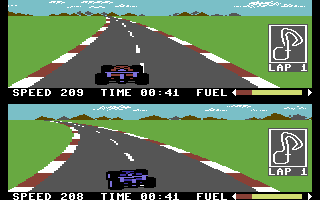
The Giant List of Videogames (here at http://dadgum.com/giantlist/list.html ) only has five entries for yourself. What other titles did you work on that are not listed there, and any stories to tell about those? Go into as much detail as you want!
There are indeed a few missing titles:
Writer Rabbit (Apple II, published by The Learning Company, 1986). I was the principle programmer and junior designer of this educational title that was eventually renamed to capitalize on the greater fame of Reader Rabbit. The principle designer was Leslie Grimm, who also created Reader Rabbit.
The Playroom (Macintosh, published by Brĝderbund, 1989). This preschool educational title was also the brainchild of Leslie Grimm. My involvement was limited to a few contributions to the design and some early prototyping. I did none of the actual Macintosh programming. I also supplied the voice of Pepper the mouse in the original Macintosh version, though my nauseatingly maudlin performance was eventually replaced.
Ultimate Air Combat (NES, published by Activison, 1992). This game was an attempt to do a first-person combat flight simulator on the NES. The game was divided into an air-to-air combat component, which was meant to resemble a first-person flight simulator, and a third-person ground-attack component, which used a more conventional scrolling background. I programmed the flight simulator portion. The NES canıt render arbitrary polygons, so our hapless artist had to draw all the graphics of the enemy aircraft in every possible size and from every possible angle by hand to allow full freedom of movement in 3D space.
Battle Bugs (IBM PC, published by Sierra, 1994 or so). While this game was published by Sierra, it was actually developed by Epyx, who hired me away from Activision while they (Epyx) were still in bankruptcy. By this time, substantially all of the management and marketing people with whom I had originally fallen out were gone. In fact, almost the only person remaining from my original stint at Epyx was Craig Nelson. On Battle Bugs, I was the sole programmer (with the exception of the sound and music software, which was partly licensed from THE Audio Solution and partly coded by Craig) and co-designed the game with Craig and many others.
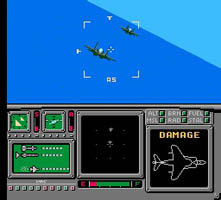
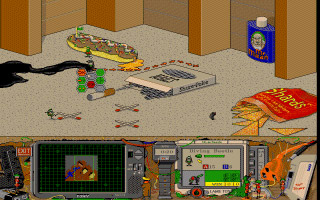
Had you left Epyx by the time the company was winding down in the late 80s? Did you get to see anything of the Handy handheld project that was to become the Lynx for example?
I left Epyx not long after Pitstop II was completed, but I remained friends with Craig Nelson, who remained at Epyx and was one of the designers of the Lynx. I actually applied for a job programming the Lynx, but Epyx was on the eve of its decline, and they discovered that they couldnıt afford to hire anybody. I still have a Lynx and several games for it. It was a fabulous little machine for its time.
If there's anything else you'd like to say to everyone out there... then go ahead :)
Until Battle Bugs, every game I had ever worked on was eventually completed and marketed. After Battle Bugs, my luck changed entirely. Nothing I worked on at Sega or 3DO ever saw the light of day, and I eventually decided that I no longer belonged in the game business and put myself out to pasture, where I have remained since.
Finally, Iıd just like to say thanks for giving me the opportunity to recall my gaming years. Iım truly amazed that anyone still remembers this stuff. I hope my responses have not been too long-winded, and thanks again for your interest and your kind words.